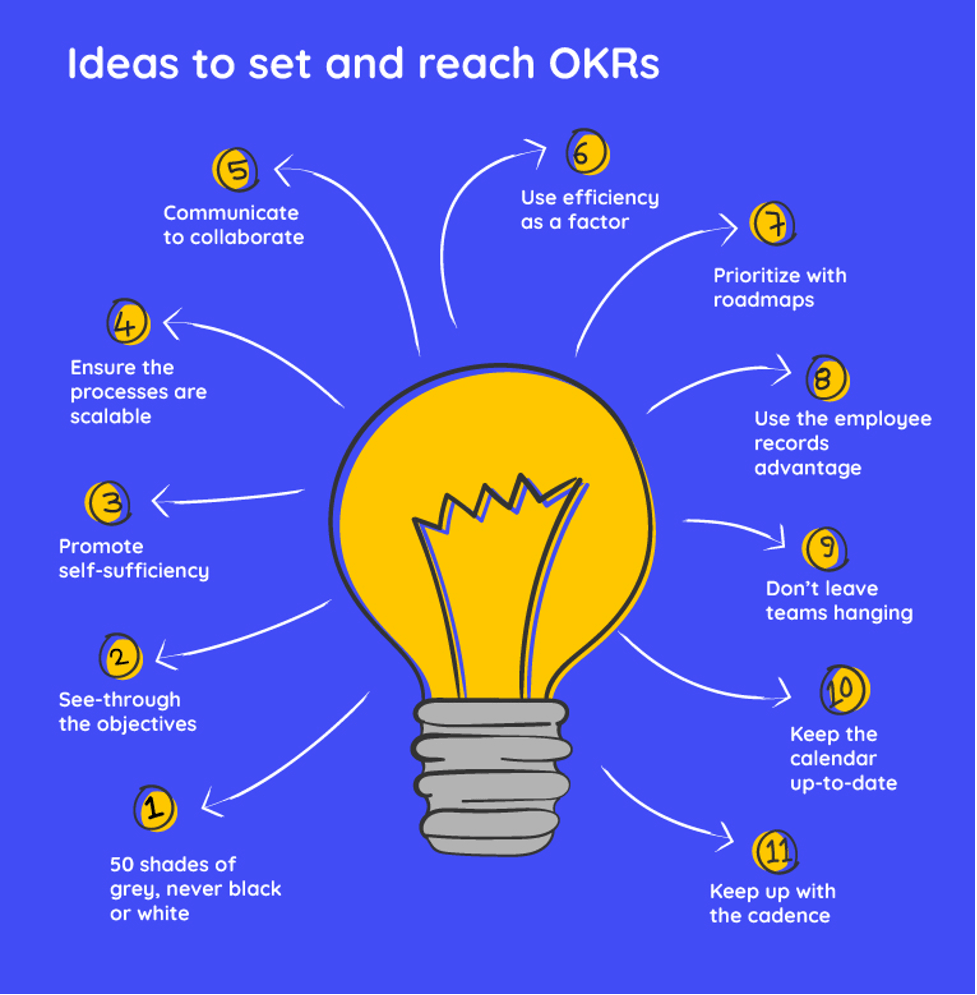Originally developed to improve efficiency at Intel, Objectives and Key Results (OKRs) got their shot at fame in the late 1990s and early 2000s, thanks to Google and its exponential growth. Tech organizations in Silicon Valley have adopted them in waves since they focus effort and ensure new initiatives are in line with the vision of the product/company. OKRs embed agile techniques into the core business instead of confining them to the software development life cycle.
Why are OKRs a good idea?
Objective key results can be a guideline for employees that act as a beacon toward the overall organizational/product goal. Managers can help their team members understand the need for their work and let them work towards achieving key results. They also set up fruitful interactions between colleagues, focusing on achieving team goals.
Some ideas to set and reach OKRs
For objective key results to be set, organizations should try a few tweaks to maximize the benefits of OKR software. Starting with the obvious “don’t tie performance management and compensation together,” there are many tips and tricks that can make the framework save time, eliminate repeat work, and more. The below focuses on having productive one-on-ones and using tools to simplify the process.

1. 50 shades of gray, never black or white
Performance goals and targets should not be restricted to traditional binary or numerical measures but instead focus on holistic, multi-dimensional, and subjective outcomes. These goals allow for a more diverse and inclusive approach to setting and tracking organizational progress. For instance, non-binary OKRs can include objectives such as “enhance customer satisfaction,” “improve employee engagement,” or “increase brand recognition.” These goals can be measured through various methods, such as customer surveys, employee feedback, or market research. Setting non-binary OKRs contributes to an employee’s comprehensive and nuanced understanding of their organization’s progress and performance. They enable organizations to focus on aspects that are important to them beyond just financial or quantitative outcomes. Managers can create a culture of continuous improvement, as they encourage employees to think creatively and holistically about their work and how they can contribute to the organization’s success. Non-binary OKRs acknowledge and value diverse perspectives, experiences, and contributions that can lead to a more motivated and engaged workforce and, ultimately, better outcomes for the organization as a whole.
2. See through the objectives
Objectives should be empowering at all levels – that means they need to be accessible and visible to everyone in the organization. Transparency allows everyone to see progress and hold each other accountable. This helps ensure everyone is working towards the same goals and objectives. Transparency fosters a culture of collaboration, trust, and teamwork. It encourages people to work together to achieve common objectives and helps to break down barriers between departments and teams. Not only is everyone on the same page, but they also understand what is expected of them – improving communication while bringing the team closer. Organizations opting for transparency can also choose to keep personal OKRs private.
3. Promote self-sufficiency
Enabling access to information allows employees to make informed decisions and cut through the red tape. Seeing the progress made through transparent OKRs can motivate employees and urge them to contribute more. Providing employees with different channels to understand the objectives helps to build trust in the company and its leadership. Allowing managers to check the progress of OKRs from their Jira instance, for example, gives them the freedom to step in when things appear unstable and provide coaching as necessary. Employees with autonomy make decisions, solve problems faster, and improve efficiency.
4. Ensure the processes are scalable
Keeping track of the organizational structure gets increasingly difficult, as the organization grows in size. With a clear structure to put next to the OKRs, managers can clarify objectives to their team members and focus on their department’s goals with everyone’s alignment. This leads to more efficient and effective use of resources, allowing the product to reach its full potential.
5. Communicate to collaborate
OKRs help increases the product’s scale by providing clarity, focus, measurable results, prioritization, collaboration, and communication. OKRs encourage collaboration and communication between teams, departments, and stakeholders. Everyone working together towards a common goal should see to it that there are no communication breakdowns that could impact the scale of the product. Following the OKR framework, the product can reach its full potential and scale up more efficiently and effectively.
6. Use efficiency as a factor
To make sure work continues uninterrupted in the workplace, it is essential to make the OKR process as unobtrusive as possible. By using the simple ticketing mechanism in Jira, managers can keep track of the OKRs of their team and encourage team members to collaborate towards a common goal. If they have measurable and quantifiable metrics at hand that are tracked and monitored over time, they can push for continuous improvement and identify areas for growth and expansion.
7. Prioritize with roadmaps
OKRs help to prioritize resources, such as time, money, and the workforce, by focusing on the most critical and impactful goals. Tying them with the roadmap can help teams focus on the features that are on the upcoming list and find ways to execute them better. They can scale or add features at the drop of a hat since their objective is to ensure product success.
8. Use the employee records advantage
Having details like employee designations to their emergency contact details at a central place gives managers and human resources team members an easy way to help employees with their personal OKRs. With attributes that are restricted, privacy can be assured, and managers can help their team members in their personal growth journey too.
9. Don’t leave teams hanging
An essential aspect of communication is when not to communicate, i.e., when employees are on leave. Managers can plan team OKRs better if they can see details of available firepower at any given moment. A detailed view of leave balances, company policies, and holiday schedules ensures a transparent leave management process. It provides managers with the leeway to accommodate their team members’ planned and unplanned needs.
10. Keep the calendar up to date
Managers who track OKRs know how difficult it is to keep track of individual and team OKRs on top of regular meetings and other non-negotiables. Having a consolidated calendar that shows leaves, issue due dates, version release dates from Jira, and other important stuff gives them back control over their time.
11. Keep up with the cadence
The frequency of check-ins is fundamental for OKRs to bear fruit. Starting with a clear understanding of what the team is trying to do, managers can conduct regular check-ins that make the team feel closer to the product vision. The frequency keeps the goals humble and key results real while allowing teams to understand their collective strengths and work on their minuses. Asking what worked and what didn’t opened up the conversation, with OKRs serving as a backdrop. Focusing on what the team hoped to achieve and comparing it against what transpired provides a reality check and allows everyone to recalibrate if needed.
Tech organizations in Silicon Valley have adopted them in waves since they focus effort and ensure new initiatives are in line with the vision of the product/company, often leveraging OKR software to streamline the process. OKRs embed agile techniques into the core business instead of confining them to the software development life cycle, fostering a culture of continuous improvement and alignment across the organization.
Can-do with OKRs
OKRs shouldn’t be overwhelming—the fewer OKRs, the better—in both numbers and levels. Two to three yearly OKRs for an organization (or product) is ideal, as it can cascade into two or three OKRs per team. With only two or three levels of OKRs, everyone can easily keep track of overall goals instead of getting lost in the maze of cascaded vital results. Leaders also try to set cross-departmental goals to enable better collaboration and reduce the overall number of OKRs in the process.










